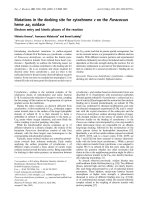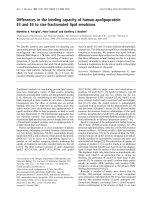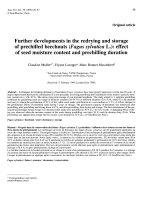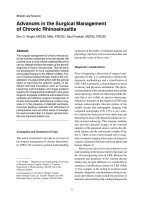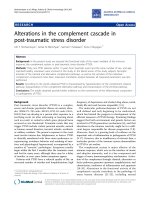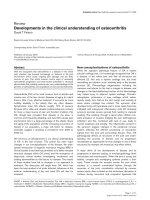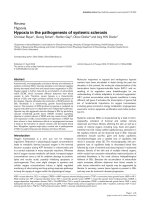Báo cáo y học: "Developments in the scientific and clinical understanding of fibromyalgia" pdf
Bạn đang xem bản rút gọn của tài liệu. Xem và tải ngay bản đầy đủ của tài liệu tại đây (131.16 KB, 8 trang )
Available online />Page 1 of 8
(page number not for citation purposes)
Abstract
Our understanding of fibromyalgia (FM) has made significant
advances over the past decade. The current concept views FM as
the result of central nervous system malfunction resulting in
amplification of pain transmission and interpretation. Research
done over the past years has demonstrated a role for poly-
morphisms of genes in the serotoninergic, dopaminergic and
catecholaminergic systems in the etiopathogenesis of FM. Various
external stimuli such as infection, trauma and stress may contribute
to the development of the syndrome. The management of FM
requires an integrated approach combining pharmacological and
nonpharmacological modalities. The recent Food and Drugs
Administration approval of pregabalin, duloxetine and milnacipran
as medications for FM may herald a new era for the development of
medications with higher specificity and efficacy for the condition.
As our understanding of the biological basis and the genetic
underpinning of FM increases, we hope to gain a better under-
standing of the true nature of the disorder, to better classify
patients and to attain more rational therapeutic modalities.
Introduction
Fibromyalgia (FM) is a chronic condition characterized by
widespread pain and diffuse tenderness, along with symp-
toms of fatigue, nonrestorative sleep and cognitive difficulties.
Although coined as a nosological entity only some two and a
half decades ago, and adorned official American College of
Rheumatology (ACR) criteria only in 1990 [1], patients
suffering from syndromes such as fibrositis and soft tissue
rheumatism have been described in the medical literature for
over a century [2]. The 1990 ACR criteria for classification of
FM formed a framework for a plethora of research and
publications focused on FM over this period. Indeed, entering
the term ‘fibromyalgia’ as a Medline search for the years
1990 to 2008 currently yields 4,271 results.
Significant progress has occurred over recent years regard-
ing our understanding of the mechanisms underlying altered
pain processing characteristic of FM, and this evolution of
knowledge is leading towards novel strategies for manage-
ment of FM pain [3]. Increasing evidence supports a genetic
predisposition to FM and supports the fact that environmental
factors may trigger the development of FM, in genetically
predisposed individuals [4-6]. There is also a continued effort
to search for biomarkers to be used to identify individuals
susceptible to FM, for the diagnosis of FM and for objective
measures of disease activity [7].
An effort has also been made to better classify FM patients, to
identify subgroups with unique clinical characteristics and to
pinpoint therapeutic interventions. The recent Food and Drugs
Administration approval of pregabalin, duloxetine and
milnacipran as specific medications for FM may herald a new
era for the development of medications with higher specificity
and efficacy for this condition. The aim of the present article is
to review the current developments in the scientific and clinical
understanding of FM and progress in the management of FM.
Classification and diagnostic criteria
ACR criteria define FM as a chronic disorder characterized
by the presence of widespread pain accompanied by tender-
ness upon palpation of at least 11 out of 18 predefined
tender points throughout the musculoskeletal system [1].
The 1990 ACR classification criteria for FM were developed
initially to facilitate research by identifying homogeneous
groups so that results from different studies could be
interpreted. In actual clinical practice it is currently common
knowledge that there is nothing particularly sacred about the
number 11. Using the ACR criteria in diagnosis of FM raises
a number of problems. Tender points and widespread pain
alone do not capture the essence of FM, multiple symptoms
of which prominently include fatigue, sleep disturbance and
cognitive dysfunction [8].
Review
Developments in the scientific and clinical understanding of
fibromyalgia
Dan Buskila
Division of Internal Medicine, Department of Medicine H, Soroka Medical Center, Faculty of Health Sciences, Ben Gurion University, P.O.B. 151, Beer
Sheva 84101, Israel
Corresponding author: Dan Buskila,
Published: 14 October 2009 Arthritis Research & Therapy 2009, 11:242 (doi:10.1186/ar2720)
This article is online at />© 2009 BioMed Central Ltd
ACR = American College of Rheumatology; FM = fibromyalgia; FSS = functional somatic syndromes.
Arthritis Research & Therapy Vol 11 No 5 Buskila
Page 2 of 8
(page number not for citation purposes)
The concept of using tender points as the defining feature of
FM has also drawn criticism [9]. The tender points have been
criticized due to the arbitrary nature of the 11-point cutoff,
due to the lack of a clear association between tender points
and the underlying pathophysiology of FM, and due to the
close association between tender points and distress, which
has led to the characterization of tender points as a sedimen-
tation rate of distress [10]. Clauw and Crofford have pointed
out that, in contrast to women being 1.5 times as likely to
experience chronic widespread pain, they are about 10 times
as likely to meet the criteria for FM [11]. It was suggested
that this disparity between the gender differential for chronic
widespread pain and FM is due solely to the ACR criteria
requiring 11 out of 18 tender points – this finding occurs 11
times more commonly in women than in men [11]. Wolfe
developed an instrument that he designated a regional pain
scale, which assessed various articular and nonarticular body
regions for pain [12]. When combined with other assess-
ments, such as a fatigue visual analog scale, the regional pain
scale correctly identified most patients diagnosed as having
FM by their rheumatologists [12].
Despite all of the critiques on the ACR criteria, these criteria
served us well by enhancing much of the research in the
field of FM. In the future, revised or newer classification
criteria should be established, incorporating the large body
of scientific data that have been gathered in the past
decade.
Subtypes of fibromyalgia
Over the years it has became clear that FM is not a homoge-
neous condition. Although chronic widespread pain and
increased tenderness are universally present, other
associated symptoms are not present in all patients. Turk and
coworkers showed that the subgroups identified by cluster
analyses of the Multidimensional Pain Inventory in various
chronic pain populations may also apply to a population of
FM patients, and that each of the FM subgroups responds
differently to treatment [13,14]. They analyzed data from
three empirically based subgroups of dysfunctional, inter-
personally distressed or adaptive coppers, all of whom under-
went a standardized treatment program, and concluded that
customizing treatment on the basis of psychosocial needs is
likely to enhance treatment efficacy. Thieme and coworkers
classified FM patients as dysfunctional, interpersonally
distressed or adaptive coppers based on their responses to
the Multidimensional Pain Inventory, and used hierarchical
regression analyses to identify the predictors of pain
behaviors for the population as a whole, and for the
subgroups [15].
These results indicated that different variables account for the
presence of pain behaviors in different subgroups of patients.
It was concluded that the data provide support for the
heterogeneity of the diagnosis of FM and have implications
for treatment of subgroups of patients [15].
A study by Giesecke and colleagues using cluster analysis
suggested that there may be three different subtypes of FM
[16]. There appeared to be a group of FM patients who
exhibit extreme tenderness but lack any associated psycho-
logical/cognitive factors, an intermediate group who display
moderate tenderness and have normal mood, and a group in
whom mood and cognitive factors may be significantly
influencing the symptom report. Recent evidence suggests a
role for polymorphisms of genes in the serotoninergic, dopa-
minergic and catecholaminergic systems in the pathogenesis
of FM [4-6]. The knowledge of these gene polymorphisms
may help with better subgrouping of FM patients in the future
and may help in designing a more specific pharmacologic
treatment approach.
Fibromyalgia – a member of the functional
somatic syndromes
Functional somatic syndromes (FSS) are defined as a group
of related syndromes characterized more by symptoms,
suffering and disability than by structural or functional
abnormality [17]. It is now known that FM overlaps and is
associated with a variety of other FSS, including chronic
fatigue syndrome, irritable bowel syndrome, post-traumatic
stress disorder, and more. Recently, Yunus has suggested
the term central sensitivity syndromes to describe FM and
related conditions [18].
The concept of central sensitivity syndrome has been
suggested to be based on mutual associations among the
central sensitivity syndrome conditions as well as the
evidence for central sensitization among several central
sensitivity syndrome members. It was suggested that such
evidence is weak or is not available in other members at this
time, however, and therefore further studies are required [18].
The biology of central sensitivity syndrome was concluded to
be based on neuroendocrine aberrations, including central
sensitization, that interact with psychosocial factors to cause
a number of symptoms [18]. Kanaan and colleagues have
suggested that phenomenological commonalities support a
close relationship between the FSS [19], although
differences remain in other domains. It was concluded that
whether the FSS may best be considered the same or
different will depend on the pragmatics of diagnosis [19].
FSS may share pathogenetic mechanisms as well. Central
sensitization that involves hyperexcitement of the central
neurons through various synaptic and neurotransmitter/neuro-
chemical activities has been demonstrated in several FSS.
Most neuroimaging studies conducted have demonstrated
differences within the central nervous system, whether at
baseline or in response to stimulation in patients with various
somatic syndromes [20].
Recent evidence suggests these syndromes may share
heritable pathophysiological features and similar polymorph-
isms of genes in the serotoninergic, dopaminergic and
catecholaminergic systems in FM and other FSS (discussed
below in Genetics) [21]. Compared with controls, female
patients with interstitial cystitis/painful bladder syndrome
showed increased activation of a defensive emotional circuit
in the context of a threat of abdominal pain [22]. It was
suggested by the authors that since these circuits have an
important role in central pain amplification related to affective
and cognitive processes, the observed abnormality may be
involved in the enhanced signals associated with interstitial
cystitis/painful bladder syndrome [22]. Bradesi and colleagues
demonstrated recently that stress-induced activation of spinal
microglia has a key role in visceral hyperalgesia and associated
spinal NK1R receptor upregulation [23]. Henningsen and
colleagues provided an overview of current concepts
underlying the management of FSS, of results of appropriate
therapeutic trials in single syndromes and diagnostic
analogues, and of practical steps for management [24]. It was
concluded that nonpharmacologic treatments involving active
participation of patients, such as exercise and psychotherapy,
seem to be more effective than those that involve passive
physical measures, including injections and operations.
Pharmacological agents with central nervous system action
seem to be more consistently effective than drugs aiming at
restoration of peripheral physiological dysfunction. Henning-
sen and colleagues suggested that a balance between
biomedical approaches, organ-oriented approaches and
cognitive interpersonal approaches is most appropriate [24].
Fibromyalgia and autoimmune disorders
FM is common in patients with autoimmune disease and may
be the source of many of the symptoms and much of the
disability in these patients [25,26]. Although FM is generally
regarded as a noninflammatory and nonautoimmune disease,
some patients have evidence of autoimmunity [27]. Although
some FM patients display autoimmunity and FM is prevalent
in autoimmune diseases, referring to FM as an autoimmune
disease is speculative at the present time. The association of
FM and autoimmune disease, specifically systemic lupus
erythematosus, may pose diagnostic dilemmas. Although FM
does not correlate with systemic lupus erythematosus
disease activity, the clinical features of FM in these patients
may contribute to misinterpretation of lupus activity [27]. The
pain associated with arthritis in these autoimmune diseases
may act as a peripheral pain generator, triggering or
enhancing widespread pain.
Genetics
Recent evidence suggests that genetic factors may play a role
in the pathogenesis of FM [4-6,21] (see Tables 1 and 2).
Certain environmental factors (stressors) may trigger the
development of FM in genetically predisposed individuals [11].
A number of studies published over recent years have
documented increased prevalence of FM among family
members of patients suffering from this syndrome [28-30].
Buskila and colleagues found that 28% of offspring of FM
patients fulfilled the 1990 ACR classification criteria for the
diagnosis of FM [28]. The authors have further reported that
the prevalence of FM among blood relatives of patients with
FM was 26%, and that the FM prevalence in male and female
relatives was 14% and 41%, respectively [29]. Arnold and
colleagues reported that FM aggregates strongly in families:
the odds ratio measuring the odds of FM in a relative of a
proband with FM versus the odds of FM in a relative of a
proband with rheumatoid arthritis was 8.5 [30]. Research
performed in recent years has demonstrated a role for
polymorphisms of genes in the serotoninergic, dopaminergic
and catecholaminergic systems in the etiology of FM
[4-6,21]. Polymorphisms in the serotonin 5-HT2A receptor
(T/T phenotype), in the serotonin transporter, in the dopamine
4 receptor and in the catecholamine O-methyltransferase
enzyme have therefore been detected at higher frequencies
in patients with FM [4-6,21].
Notably, these polymorphisms all affect the metabolism or
transport of monoamines, compounds that have a critical role
in both sensory processing and the human stress response
[31]. These polymorphisms are not specific for FM and are
associated with other FSS. The mode of inheritance of FM is
unknown but it is most probably polygenic.
Future large, well-designed studies are needed to further
clarify the role of genetic factors in FM. The knowledge of
Available online />Page 3 of 8
(page number not for citation purposes)
Table 1
Genetic markers in fibromyalgia
System Genetic marker
Serotoninergic 5-HT2A receptor polymorphism T/T
phenotype
SLC6A4 serotonin transporter
Dopaminergic Dopamine D
4
receptor exon III repeat
polymorphism
Catecholaminergic Catecholamine O-methyl transferase
polymorphism
Table 2
Future clinical implications of molecular genetic findings in
fibromyalgia
Subgrouping of fibromyalgia patients
Pharmacologic treatment based on knowledge of patient’s genotype
• Subjects with the short 5-HTTLPR allele may be more suitable
candidates for antidepressant medication
• Subjects without the 7DRD4 allele may be candidates for
dopaminergic medication
these gene polymorphisms may help with better subgrouping
of FM patients and in designing a more specific pharma-
cologic treatment approach.
Triggers
In addition to the genetic associations, various external stimuli
such as infection, trauma and stress may contribute to
development of the syndrome (see Table 3). Bennett and
colleagues provided an Internet survey of 2,596 people with
FM [32]. Approximately 21% of responders indicated that
they could not identify any triggering events of their illness.
Over 73% of those who indicated some triggering event
made attributions to emotional trauma or chronic stress. The
next most common attribution was acute illness (26.7%),
followed by physical stressors (surgery, motor vehicle
collisions, and other injuries). Various infectious agents have
been linked to the development of FM as well as to that of the
closely related chronic fatigue syndrome.
Viral agents, including hepatitis C and HIV, have been
associated with FM on epidemiological and clinical grounds
[33,34]. In particular cases, such as Lyme disease and HIV,
obvious overlap of clinical manifestations can be described;
nonetheless, evidence of the utility of antibiotic or antiviral
treatment in FM or chronic fatigue syndrome is lacking [35].
Various forms of physical trauma have been implicated as
triggering events in the pathogenesis of FM. Increased rates
of FM have been demonstrated among patients undergoing
cervical trauma during motor vehicle accidents [36]. Most
recently, Wynne-Jones and colleagues found a 7.8%
frequency of widespread pain within 12 months among a
cohort of patients who underwent a motor vehicle collision
[37]. Emotional trauma and stress have also been implicated
as triggers of FM. Post-traumatic stress disorder may
precipitate the development of FM, and both conditions share
similar pathogenic mechanisms [38].
Pathogenesis of fibromyalgia
Tremendous progress in the past decade has been made in
our understanding of FM, which is now recognized as one of
many central pain syndromes [31]. Central sensitization is an
emerging biopsychosocial concept currently considered to
characterize a wide spectrum of interrelated FSS, which may
subsequently be better defined as central sensitivity
syndromes [18].
Central sensitization constitutes a condition of general over-
reactivity of the central nervous system to a wide spectrum of
stimulation.
Various areas in the central nervous system are responsible
for inhibiting ascending pain transmission within the spinal
cord through the activity of inhibitory neurotransmitters, which
include serotonin, norepinephrine, enkephalins, γ-amino
butyric acid and adenosine. A decrease in this pain inhibitory
loop is an important component of central sensitization
syndrome [39]. Separate areas of the central nervous system,
including the limbic system and the medial thalamic nuclei,
are involved in the affective response of the central nervous
system to pain [40].
The advent of imaging techniques has provided valuable
insight into the biological meaning of central sensitization in
FM. Using functional magnetic resonance imaging, Gracely
and colleagues were able to demonstrate that conditions
resulting in comparable subjective sensation of pain also
resulted in activation patterns that were similar in FM patients
and control individuals; on the other hand, similar levels of
pressure (which invoke higher levels of pain among FM
patients relative to control individuals) resulted in activation of
different areas and caused greater effects in patients [41].
Cook and colleagues similarly showed that, in response to
painful stimuli, FM patients had greater activity in the
contralateral insular cortex than healthy control individuals
[42], as demonstrated by functional magnetic resonance
imaging. Pain catastrophizing was significantly associated
with increased activity in some brain areas related to
anticipation of pain (medial frontal cortex, cerebellum),
attention to pain (dorsal anterior cingulate cortex, dorsolateral
prefrontal cortex) and emotional aspects of pain [43]. These
results suggested that catastrophizing influences pain
perception by altering attention and anticipation, and by
heightening emotional responses to pain [43]. A recent study
by Harris and colleagues used μ-opioid receptor positron
emission tomography in FM patients and in matched healthy
control individuals [44]. The study demonstrated that FM
patients display reduced μ-opioid receptor within several
regions that play an important role in pain regulation, such as
the nucleus accumbens, the dorsal cingulate and the
amygdala. These results indicate altered endogenous opioid
analgesic activity in FM and explain why exogenous opiates
appear to have reduced efficacy in this population.
Changes in glutamate levels within the insula were demon-
strated recently to be associated with changes in multiple
pain domains in patients with FM [45]. It was suggested that
proton magnetic resonance spectroscopy data may serve as
a useful biomarker and surrogate endpoint for clinical trials of
FM. Functional brain imaging techniques have thus supplied
Arthritis Research & Therapy Vol 11 No 5 Buskila
Page 4 of 8
(page number not for citation purposes)
Table 3
Triggers capable of precipitating fibromyalgia
Physical trauma
Psychologic stress/distress (acute and/or chronic)
Infections
Peripheral pain syndromes (autoimmune diseases, osteoarthritis,
complex regional pain syndrome)
FM researchers with a long-awaited tool for objective
evaluation of pain. This tool enables further evaluation of
various factors capable of influencing the functioning of the
nervous system as well as response to pharmacological
interventions. Perturbations in the hypothalamic–pituitary–
adrenal axis have been demonstrated in FM patients [46].
Similarly, alterations in the functioning of the autonomic
nervous system have frequently been described in FM [47].
Autonomic dysfunction is inherent to FM [48]. Sympathetic
hyperactivity has been described by diverse groups of
investigators in FM [49]. Cohen and colleagues reported on
abnormal sympathovagal balance in men with sympathetic
hyperactivity and concomitantly reduced parasympathetic
activity [50]. The basal autonomic state of patients with FM
was characterized by increased sympathetic and decreased
parasympathetic tones in women with FM [51]. It was
suggested that autonomic dysregulation may have implica-
tions regarding the symptomatology, physical and psycho-
logical aspects of health status [51].
Solano and colleagues reported that patients with FM have
multiple nonpain symptoms related to different expressions of
autonomic dysfunction, and that there was a correlation
between the Fibromyalgia Impact Questionnaire and an
autonomic dysfunction questionnaire [48].
Nonrestorative sleep is common in FM. About 75% of
patients report sleep disturbances, including early middle or
late insomnia, hypersomnia and frequent awakening. Moldofsky
and colleagues were the first to demonstrate that the
disruption of stage 4 nonrapid eye movement or deep sleep
in normal healthy people by noise stimuli resulted in
complaints of unrefreshing sleep, variable aching and fatigue
[52]. FM patients reported more insomnia-related symptoms
than either rheumatoid arthritis patients or a population
sample [53]. The higher prevalence of insomnia-related
symptoms among FM patients was not explained by
depression or pain [53].
Finally, there is a continuous effort to identify objective
measurable biomarkers in FM patients that may identify sus-
ceptible individuals, may facilitate diagnosis or that parallel
activity of the disease [54]. Dadabhoy and colleagues
provided a systematic literature review assessing highly
investigated, objective measures used in FM studies. The
authors concluded that to date only experimental pain testing
has been shown to coincide with improvements in clinical
status in a longitudinal study [54].
Concerted efforts to systematically evaluate additional
objective measures in research trials have been suggested
vital for ongoing progress in outcome research and trans-
lation into clinical practice [54].
Management of fibromyalgia
As FM is a complex syndrome associated with a wide range
of symptoms, treatment should be tailored to the individual,
dealing with their particular needs and targeting their most
distressing symptoms. The aim of treating FM is to decrease
pain and to increase function by means of a multimodal
therapeutic strategy, which in most cases includes pharma-
cologic interventions [55,56]. Recently, the Food and Drugs
Administration approved three drugs for the treatment of FM:
pregabalin, duloxetine, and milnacipran (see Table 4). This
fact may herald a new era for the development of medication
with higher specificity and efficacy for this condition.
Pregabalin is an α
2
δ ligand that reduces calcium influx at
nerve terminals and therefore reduces the release of several
neurochemicals, including glutamate, noradrenalin and sub-
stance P [57]. Crofford and colleagues [58] compared the
effects of pregabalin (150, 300 and 450 mg/day) on pain,
sleep, fatigue and health-related quality of life in 529 FM
patients, and found that it was superior to placebo in
reducing the scores for pain, the short-form McGill Pain
Questionnaire, the sleep index, fatigue, patient and clinician
global impression of change, and four of the eight short-form
SF-36 domains. Arnold and colleagues reported that anxiety
symptoms were more common than depressive symptoms in
their cohort of FM patients and that the pain treatment effect
of pregabalin did not depend on baseline anxiety or
depressive symptoms [59], suggesting that pregabalin
improves pain in patients with or without these symptoms.
Much of the pain reduction appeared to be independent of
improvements in anxiety or mood symptoms [59].
Mease and colleagues evaluated the efficacy and safety of
pregabalin for symptomatic relief of pain associated with FM
and for management of FM [60]. This multicenter, double-
blind, placebo-controlled trail randomly assigned 748
Available online />Page 5 of 8
(page number not for citation purposes)
Table 4
Drugs approved by the Food and Drugs Administration for treatment of fibromyalgia
Drug Class Mechanism
Duloxetine Antidepressant Balanced norepinephrine and serotonin reuptake inhibition
Milnacipran Antidepressant Balanced norepinephrine and serotonin reuptake inhibition
Pregabalin Anticonvulsant α
2
δ ligand; affects calcium influx and release of excitatory amino acids and neuropeptides
patients with FM to receive placebo or pregabalin 300, 450
or 600 mg/day for 13 weeks. Patients in all pregabalin groups
showed statistically significant improvement in the endpoint
mean pain score and in patient global impression of change
response compared with placebo. Improvements in the
Fibromyalgia Impact Questionnaire total score for the
pregabalin groups were numerically greater but not
significantly greater than those for the placebo group. The
authors concluded that pregabalin provides clinically
meaningful benefit to patients with FM.
In another study Mease and colleagues evaluated the safely
and efficacy of milnacipran, a dual norepinephrine and
serotonin reuptake inhibitor in the treatment of FM, in a 27-
week randomized, double-blind, multicenter study [61]. They
compared milnacipran 100 and 200 mg/day with placebo in
the treatment of 888 patients with FM. At the primary end-
point, after 3 months of stable dose treatment, a significantly
higher percentage of milnacipran-treated patients met the
criteria than FM responders versus placebo. A significantly
higher percentage of patients treated with milnacipran
200 mg/day also met the criteria as FM pain responders
versus placebo. At 15 weeks, milnacipran 200 mg/day led to
significant improvements over placebo in pain, patient global
impression of change, fatigue, cognition and multiple short-
form SF-36 domains. Milnacipran was safe and well tolerated
by the majority of patients during 27 weeks of treatment [61].
In a different study, both doses of milnacipran (100 and
200 mg/day) were associated with significant improvements
in pain and other symptoms [62].
Duloxetine is a norepinephrine and serotonin reuptake
inhibitor. Two 12-week randomized, double-blind, placebo-
controlled trials have evaluated duloxetine in patients with FM
[63,64]. Compared with patients on placebo, FM patients
treated with duloxetine 60 mg once daily or with duloxetine
60 mg twice daily had significantly greater improvement in
remaining Brief Pain Inventory pain severity and interference
scores, Fibromyalgia Impact Questionnaire scores, Clinical
Global Impression of Severity scores, Patient Global
Impression of Improvement scores, and several quality of life
measures. The authors concluded that both duloxetine 60 mg
once daily and duloxetine 60 mg twice daily were effective
and safe in the treatment of FM in female patients with or
without major depressive disorder [63]. In the other rando-
mized controlled 12-week trial, duloxetine was an effective
and safe treatment for many of the symptoms associated with
FM in subjects with or without major depressive disorder,
particularly for women who had significant improvement
across most outcome measures [64].
Hauser and colleagues provided a meta-analysis of clinical
trials (randomized controlled trials) assessing the efficacy of
multicomponent treatment in FM [65]. There was strong
evidence for the efficacy of multicomponent therapy to
reduce some key symptoms of FM, such as pain, fatigue and
depressed mood, and to improve self-efficacy and physical
fitness post treatment. There was also strong evidence that
the positive effects of multicomponent therapy on the key
symptoms of FM decline with time [65]. A systematic review
of papers on antidepressants in rheumatological conditions
was performed [66]. The strongest evidence on an analgesic
effect of antidepressants has been obtained for FM.
Analgesic effects of antidepressants were independent of
their antidepressant effects. Tricyclic antidepressants, even at
low doses, had analgesic effects equivalent to those of
serotonin and noradrenalin reuptake inhibitors, but were less
well tolerated. Selective serotonin reuptake inhibitors had
modest analgesic effects, but higher doses were required to
achieve analgesia [66].
A systematic review on the effectiveness of treatment with
antidepressants in fibromyalgia syndrome found that amitrip-
tyline 25 to 50 mg/day reduces pain, fatigue and depressive-
ness in patients with FM, and improves sleep and quality of
life [67]. It was concluded that most selective serotonin
reuptake inhibitors and the serotonin and noradrenalin
reuptake inhibitors duloxetine and milnacipran are probably
also effective. The review suggested that short-term
treatment of patients with FM using amitriptyline or another of
the antidepressants that were effective in randomized
controlled trials can be recommended. It was stressed that
data on long-term efficacy are lacking [67]. A EULAR task
force developed management recommendations for FM
based on a systematic review [68]. The nine recommen-
dations included eight management categories; three of
which had strong evidence from the current literature, and
three were based on expert opinion [68]. Clinical studies
demonstrate the effectiveness of the α
2
δ ligands (gaba-
pentine and pregabalin) and the norepinephrine/serotonin
reuptake inhibitors (duloxetine and milnacipran) in FM [69].
Exercise is a crucial part of treatment for FM patients.
A comprehensive review of 46 exercise treatment studies in
FM reported that the strongest evidence was in support of
aerobic exercise [70]. In general, the greatest effect and
lowest attrition occurred in exercise programs that were of
lower intensity than those of higher intensity [70]. The
combination of nonpharmacological treatments such as
exercise programs and psychological support together with
analgesics and off-label use of tricyclic medications,
sedative hypnotics and reuptake inhibitors have all led to
limited success; the recent introduction of pregabalin, an
α
2
δ ligand, and the serotonin and noradrenalin reuptake
inhibitors duloxetine and milnacipran is a promising
development in the field of FM [71]. The current research
being carried out on novel sedative hypnotics, antiepileptic
medications, various reuptake inhibitors, growth hormone
agonists, canabinoid agonists and 5-HT3 antagonists offers
hope for future improvement in our therapeutic options for
dealing with FM.
Arthritis Research & Therapy Vol 11 No 5 Buskila
Page 6 of 8
(page number not for citation purposes)
Conclusion
Major progress has been reached in our understanding of FM
in the past decade. High prevalence marks the syndrome that
is considered to reflect altered central pain processing.
Genetic and environmental factors may play a role in the
etiopathology of FM and other related syndromes. FM
requires a multimodal management program including
pharmacologic and nonpharmacologic modalities.
New medications have been developed and clinical studies
demonstrate the effectiveness of the α
2
δ ligands (pregabalin)
and the serotonin and noradrenalin reuptake inhibitors
(duloxetine and milnacipran). As our understanding of the
biological basis in general – and the genetic underpinning, in
particular – of FM increases, we hope to gain a better
understanding of the true nature of the disorder, to attain
more rational therapeutic modalities, and to help patients.
Competing interests
The author declares that he is a consultant and on the
speaker bureaus for Pfizer and Pierre Fabre Medicament.
References
1. Wolfe F, Smythe HA, Yunus MB, Bennett RM, Bombardier C,
Goldenberg DL, Tugwell P, Campbell SM, Abeles M, Clark P, Fam
AD, Farber SJ, Flechtner JJ, Franklin CM, Gatter RA,Hamaty D,
Lessard J, Lichtbroun AS, Masi AT, McCain GA, Reynolds WJ.
Romano TJ, Russell IJ, Sheon RP: The American College of
Rheumatology criteria for the classification of fibromyalgia:
report of the multicenter criteria committee. Arthritis Rheum
1990, 33:160-172.
2. Inanici F, Yunus MB: History of fibromyalgia: past to present.
Curr Pain Headache Rep 2004, 8:369-378.
3. Ablin J, Neumann L, Buskila D: Pathogenesis of fibromyalgia – a
review. Joint Bone Spine 2008, 75:273-279.
4. Buskila D: Genetics of chronic pain states. Best Pract Res Clin
Rheumatol 2007, 21:535-547.
5. Buskila D, Sarzi-Puttini P, Ablin JN: The genetics of fibromyalgia
syndrome. Pharmacogenomics 2007, 8:67-74.
6. Ablin JN, Cohen H, Buskila D: Mechanisms of disease: genetics
of fibromyalgia. Nat Clin Pract Rheumatol 2006, 2:671-678.
7. Dadabhoy D, Crofford LJ, Spaeth M, Russell IJ, Clauw DJ:
Biology and therapy of fibromyalgia. Evidence-based bio-
markers for fibromyalgia syndrome. Arthritis Res Ther 2008,
10:211.
8. Crofford LJ, Clauw DJ: Fibromyalgia: where are we a decade
after the American College of Rheumatology classification cri-
teria were developed? Arthritis Rheum 2002, 46:1136-1138.
9. Harth M, Nielson WR: The fibromyalgia tender points: use
them or lose them? A brief review of the controversy.
J Rheumatol 2007, 34:914-922.
10. Wolfe F: The relation between tender points and fibromyalgia
symptom variables: evidence that fibromyalgia is not a dis-
crete disorder in the clinic. Ann Rheum Dis 1997, 56:268-271.
11. Clauw DJ, Crofford LJ: Chronic widespread pain and fibromyal-
gia: what we know, and what we need to know. Best Pract Res
Clin Rheumatol 2003, 17:685-701.
12. Wolfe F: Pain extent and diagnosis: development and valida-
tion of the regional pain scale in 12,799 patients with
rheumatic disease. J Rheumatol 2003, 30:369-378.
13. Turk DC, Okifuji A, Sinclair JD, Starz TW: Pain, disability and
physical functioning in subgroups of patients with fibromyal-
gia. J Rheumatol 1996, 23:1255-1262.
14. Turk DC, Okifuji A, Sinclair JD, Starz TW: Differential responses
by psychosocial subgroups of fibromyalgia syndrome
patients to an interdisciplinary treatment. Arthritis Care Res
1998, 11:397-404.
15. Thieme K, Spies C, Sinha P, Turk DC, Flor H: Predictors of pain
behaviors in fibromyalgia syndrome.
Arthritis Rheum 2005, 53:
343-350.
16. Giesecke T, Williams DA, Harris RE, Cupps TR, Tian X, Tian TX,
Gracely RH, Clauw DJ: Sub grouping of fibromyalgia patients
on the basis of pressure-pain thresholds and psychological
factors. Arthritis Rheum 2003, 48:2916-2922.
17. Masuko K, Nakamura H: Functional somatic syndrome: how it
could be relevant to rheumatologists. Mod Rheumatol 2007,
17:179-184.
18. Yunus MB: Fibromyalgia and overlapping disorders: the unify-
ing concept of central sensitivity syndromes. Semin Arthritis
Rheum 2007, 36:339-356.
19. Kanaan RA, Lepine JP, Wessely SC: The association or other-
wise of the functional somatic syndromes. Psychosom Med
2007, 69:855-859.
20. Wood PB: Neuroimaging in functional somatic syndromes. Int
Rev Neurobiol 2005, 67:119-163.
21. Buskila D, Sarzi-Puttini P: Biology and therapy of fibromyalgia.
Genetic aspects of fibromyalgia syndrome. Arthritis Res Ther
2006, 8:218.
22. Twiss C, Kilpatrick L, Craske M, Buffington CA, Ornitz E, Rod-
riguez LV, Mayer EA, Naliboff BD: Increased startle responses
in interstitial cystitis: evidence for central hype responsive-
ness to visceral related threat. J Urol 2009, 181:2127-2133.
23. Bradesi S, Svensson CI, Steinauer J, Pothoulakis C, Yaksh TL,
Mayer EA: Role of spinal microglia in visceral hyperalgesia
and NK 1R up–regulation in a rat model of chronic stress.
Gastroenterology 2009, 136:1339-1348.
24. Henningsen P, Zipfel S, Herzog W: Management of functional
somatic syndromes. Lancet 2007, 369:946-955.
25. Neumann L, Buskila D: Epidemiology of fibromyalgia. Curr Pain
Headach Rep 2003, 7:362-363.
26. Buskila D, Press J, Abu-shakra M: Fibromyalgia in systemic
lupus erythematosus: prevalence and clinical implications.
Clin Rev Allergy Immunol 2003, 25:25-28.
27. Buskila D, Sarzi-Puttini P: Fibromyalgia and autoimmune dis-
eases: the pain behind autoimmunity. Isr Med Assoc J 2008,
10:77-78.
28. Buskila D, Neumann L, Hazanov I, Carmi R: Familial aggregation
in the fibromyalgia syndrome. Semin Arthritis Rheum 1996, 26:
605-611.
29. Buskila D, Neumann L: Fibromyalgia syndrome (FM) and non-
articular tenderness in relatives of patients with FM. J Rheu-
matol 1997, 24:941-944.
30. Arnold LM, Hudson J, Hess EV, Ware AE, Fritz DA, Auchenbach
MB, Starck LO, Keck PE, Jr: Family study of fibromyalgia. Arthri-
tis Rheum 2004, 50:944-952.
31. Dadabhoy D, Clauw DJ: Therapy insight: fibromyalgia a differ-
ent type of pain needing a different type of treatment. Nat Clin
Pract Rheumatol 2006, 2:364-372.
32. Bennett RM, Jones J, Turk DC, Russell IJ, Matallana L: An internet
survey of 2,596 people with fibromyalgia. BMC Musculoskelet
Disord 2007, 8:27.
33. Buskila D, Shnaider A, Neumann L, Zilberman D, Hilzenrat N,
Sikuler E: Fibromyalgia in hepatitis C virus infection. Another
Available online />Page 7 of 8
(page number not for citation purposes)
This article is part of a special collection of reviews, The
Scientific Basis of Rheumatology: A Decade of
Progress, published to mark Arthritis Research &
Therapy’s 10th anniversary.
Other articles in this series can be found at:
/>The Scientific Basis
of Rheumatology:
A Decade of Progress
infectious disease relationship. Arch Intern Med 1997, 157:
2497-2500.
34. Buskila D, Gladman DD, Langevitz P, Urowitz S, Smythe HA:
Fibromyalgia in human immunodeficiency virus infection.
J Rheumatol 1990, 17:1202-1206.
35. Ablin JN, Shoenfeld Y, Buskila D: Fibromyalgia, infection and
vaccination: two more parts in the etiological puzzle. J Autoim-
mun 2006, 27:145-152.
36. Buskila D, Neumann L, Vaisberg G, Alkalay D, Wolfe F: Increased
rates of fibromyalgia following cervical spine injury. A con-
trolled study of 161 cases of traumatic injury. Arthritis Rheum
1997, 40:446-452.
37. Wynne-Jones G, Jones GT, Wiles NJ, Silman AJ, Macfarlane GJ:
Predicting new onset of widespread pain following a motor
vehicle collision. J Rheumatol 2006, 33:968-974.
38. Buskila D, Cohen H: Comorbidity of fibromyalgia and psychi-
atric disorders. Curr Pain Headache Rep 2007, 11:333-338.
39. Millan MJ: Descending control of pain. Prog Neurobiol 2002,
66:355-474.
40. Price DD: Psychological and neural mechanisms of the affec-
tive dimension of pain. Science 2000, 288:1769-1772.
41. Gracely RH, Petzke F, Wolf JM, Clauw DJ: Functional magnetic
resonance imaging evidence of augmented pain processing
in fibromyalgia. Arthritis Rheum 2002, 46:1333-1343.
42. Cook DB, Lange G, Ciccone DS, Liu WC, Steffener J, Natelson
BH: Functional imaging of pain in patients with primary
fibromyalgia. J Rheumatol 2004, 31:364-378.
43. Gracely RH, Geisser ME, Giesecke T, Grant MA, Petzke F,
Williams DA, Clauw DJ: Pain catastrophizing and neural
responses to pain among persons with fibromyalgia. Brain
2004, 127:835-843.
44. Harris RE, Clauw DJ, Scott DJ, Mclean SA, Gracely RH, Zubieta
JK: Decreased central mu-opioid receptor availability in
fibromyalgia. J Neurosci 2007, 27:10,000-10,006.
45. Harris RE, Sundgren PC, Pang Y, Hsu M, Petrou M, Kim SH,
McLean SA, Gracely RH, Clauw DJ: Dynamic levels of gluta-
mate within the insula are associated with improvements in
multiple pain domains in fibromyalgia. Arthritis Rheum 2008,
58:903-907.
46. Crofford LJ, Pillemer SR, Kalogeras KT, Cash JM, Michelson D,
King MA, Sternberg EM, Gold PW, Chrousos GP, Wilder RL:
Hypothalamic–pituitary–adrenal axis perturbations in patients
with fibromyalgia. Arthritis Rheum 1994, 37:1583-1592.
47. Cohen H, Neumann L, Kotler M, Buskila D: Autonomic nervous
system derangement in fibromyalgia syndrome and related
disorders. Isr Med Assoc J 2001, 3:755-760.
48. Solano C, Martinez A, Becerril L, Vargas A, Figueroa J, Navarro C,
Ramos-Remus C, Martinez-Lavin M: Autonomic dysfunction in
fibromyalgia assessed by the composite autonomic symp-
toms scale (COMPASS). J Clin Rheumatol 2009, 15:172-176.
49. Martinez-Lavin M: Biology and therapy of fibromyalgia. Stress,
the stress response system, and fibromyalgia. Arthritis Res
Ther 2007, 9:216.
50. Cohen H, Neumann L, Alhosshle A, Kotler M, Abu-Shakra M,
Buskila D: Abnormal sympathovagal balance in men with
fibromyalgia. J Rheumatol 2001, 28:581-589.
51. Cohen H, Neumann L, Shore M, Amir M, Cassuto Y, Buskila D:
Autonomic dysfunction in patients with fibromyalgia: applica-
tion of power spectral analysis of heart rate variability. Semin
Arthritis Rheum 2000, 29:217-227.
52. Moldofsky H, Scarisbrick P, England R, Smythe H: Muscu-
loskeletal symptoms and non-REM sleep disturbance in
patients with ‘fibrositis syndrome’ and healthy subjects. Psy-
chosom Med 1975, 37:341-351.
53. Belt NK, Kronholm E, Kauppi MJ: Sleep problems in fibromyal-
gia and rheumatoid arthritis compared with the general popu-
lation. Clin Exp Rheumatol 2009, 27:35-41.
54. Dadabhoy D, Crofford LJ, Spaeth M, Russell IJ, Clauw DJ:
Biology and therapy of fibromyalgia. Evidence-based bio-
markers for fibromyalgia syndrome. Arthritis Res Ther 2008,
10:211.
55. Burckhardt CS: Multidisciplinary approaches for management
of fibromyalgia. Curr Pharm Design 2006, 12:59-66.
56. Sarzi-Puttini P, Buskila D, Carrabba M, Doria A, Atzeni F: Treat-
ment strategy in fibromyalgia syndrome: where are we now?
Semin Arthritis Rheum 2008, 37:353-365.
57. Fink K, Dooley DJ, Meder WP, Suman-Chauhan N, Duffy S, Clus-
mann H: Inhibition of neuronal Ca
2+
influx by gabapentin and
pregabalin in the human neocortex. Neuropharmacology 2002,
42:229-236.
58. Crofford LJ, Rowbotham MC, Mease PJ, Russell IJ, Dworkin RH,
Corbin AE, Young JP Jr, LaMoreaux LK, Martin SA, Sharma U;
Pregabalin 1008-105 Study Group: Pregabalin for the treat-
ment of fibromyalgia syndrome: results of a randomized,
double blind placebo-controlled trial. Arthritis Rheum 2005,
52:1264-1273.
59. Arnold LM, Crofford LJ, Martin SA, Young JP, Sharma U: The
effect of anxiety and depression on improvements in pain in a
randomized controlled trial of pregabalin for treatment of
fibromyalgia. Pain Med 2007, 8:633-639.
60. Mease PJ, Russell IJ, Arnold LM, Florian H, Young JP Jr, Martin
SA, Sharma M: A randomized, double blind placebo controlled,
phase III trial of pregabalin in the treatment of patients with
fibromyalgia. J Rheumatol 2008, 35:502-514.
61. Mease PJ, Clauw DJ, Gendreau RM, Rao SG, Kranzler J, Chen W,
Palmer RH: The efficacy and safety of milnacipran for treat-
ment of fibromyalgia. A randomized, double blind, placebo
controlled trial. J Rheumatol 2009, 36:398-409.
62. Clauw DJ, Mease P, Palmer RH, Genderau RM, Wang Y: Mil-
nacipran for the treatment of fibromyalgia in adults: a 15-
week multicenter, randomized, double blind placebo
controlled, multiple dose clinical trial. Clin Ther 2008, 30:
1988-2004.
63. Arnold LM, Rosen A, Pritchett YL, D’ Souza DN, Goldstein DJ,
Ivengar S, Wernicke JF: A randomized, double blind placebo
controlled trial of duloxetine in the treatment of women with
fibromyalgia with or without major depressive disorder. Pain
2005, 119:5-15.
64. Arnold LM, Lu Y, Crofford LJ, Wohlreich M, Detke MJ, Iyengar S,
Goldstien DJ: A double blind multicenter trial comparing
duloxetine with placebo in the treatment of fibromyalgia
patients with or without major depressive disorder. Arthritis
Rheum 2004, 50:2974-2984.
65. Hauser W, Bernardy K, Arnold B, Offenbacher M, Schiltenwolf M:
Efficacy of multicomponent treatment in fibromyalgia syn-
drome: a meta analysis of randomized controlled clinical
trials. Arthritis Rheum 2009, 61:216-224.
66. Perrot S, Jovier RM, Marty M, Jeunne C, Laroche F, and the
Cercle d’Etude de la Douleur en Rheumatologie France, French
Rheumatological Society, Pain Study Section: Is there any evi-
dence to support the use of anti depressants in painful
rheumatological conditions? Systematic review of pharmaco-
logical and clinical studies. Rheumatology 2008, 7:1117-1123.
67. Uceyler N, Hauser W, Sommer C: A systematic review on the
effectiveness of treatment with antidepressants in fibromyal-
gia syndrome. Arthritis Rheum 2008, 59:1279-1298.
68. Carville SF, Arendt-Nielsen S, Bliddal H, Blotman F, Branco JC,
Buskila D, Da Silva JA, Danneskiold-Samsoe B, Dincer F, Henriks-
son C, Henriksson KG, Kosek E, Longley K, McCarthy GM, Perrot
S, Puszczewicz M, Sarzi-Puttini P, Silman A, Spath M, Choy EH;
EULAR: EULAR evidence-based recommendations for the
management of fibromyalgia syndrome. Ann Rheum Dis 2008,
67:1536-1541.
69. Crofford LJ: Pain managemnent in fibromyalgia. Curr Opin
Rheumatol 2008, 20:246-250.
70. Jones KD, Adams D, Winters-Stone K, Burckhardt CS: A Com-
prehensive review of 46 exercise treatment studies in
fibromyalgia (1988–2005). Health Qual Life Outcomes 2006, 4:
67.
71. Ablin JN, Buskila D: Emerging therapies for fibromyalgia. Expert
Opin Emerging Drugs 2008, 13:53-62.
Arthritis Research & Therapy Vol 11 No 5 Buskila
Page 8 of 8
(page number not for citation purposes)
